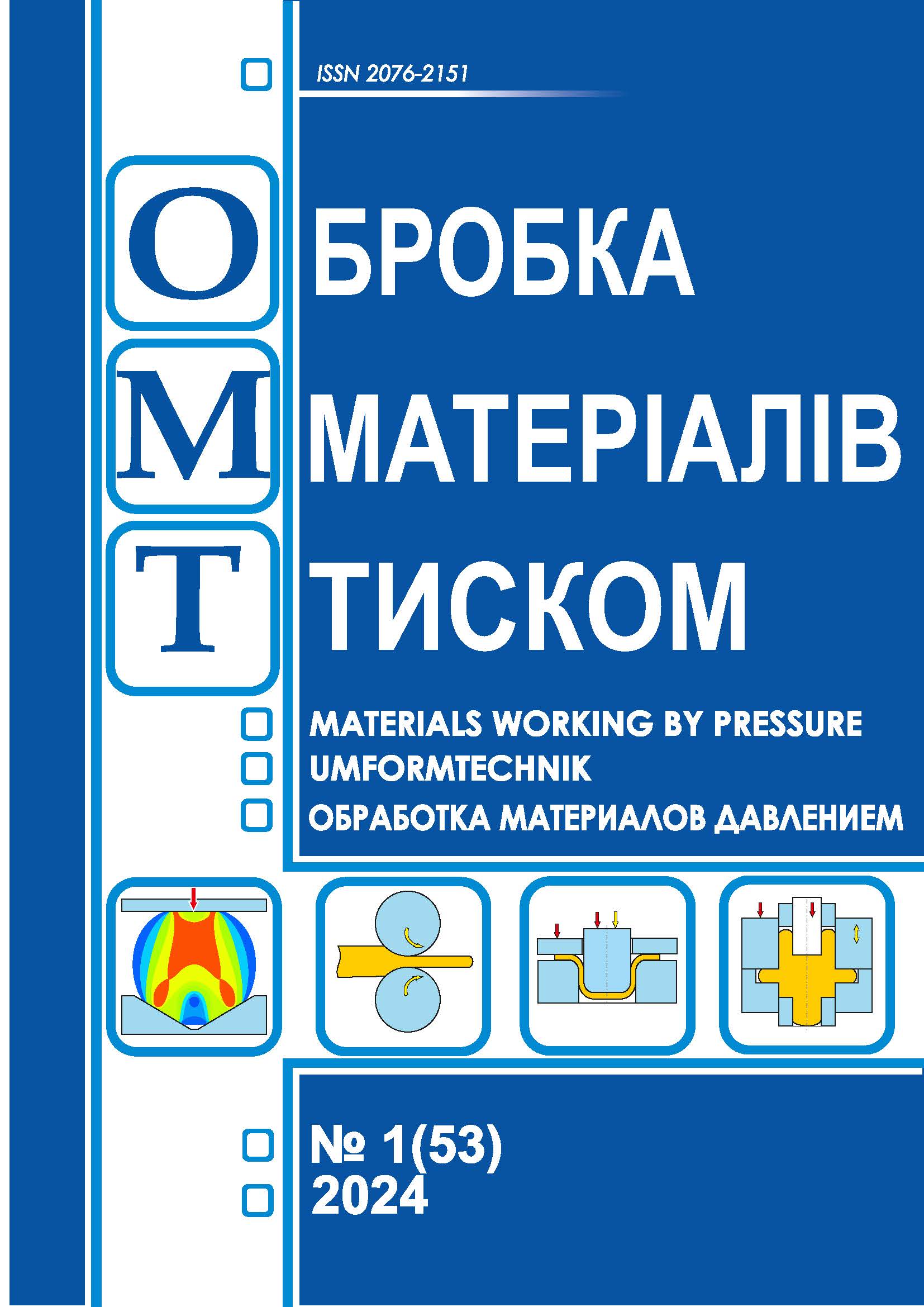Hole flanging at the bottom of the hollow semi-finished product after deep drawing
DOI:
https://doi.org/10.37142/2076-2151/2024-1(53)80Keywords:
hollow semi-finished product, hole flanging, finite element method, force, stress, deformation, plasticity resource.Abstract
Kaliuzhnyi O., Kaliuzhnyi V., Levchenko V.
Hole flanging at the bottom of the hollow semi-finished product after deep drawing
In the article the research results obtained using the finite element method and the DEFORM program in simulation the process of axisymmetric flanging with forming a flange along the contour of the hole in the bottom part of a circular hollow semi-finished product drawn from a sheet workpiece from AISI-1010COLD steel are presented. Thinning and deformations in the bottom part after drawing were considered. An elastic-plastic model of the metal was used. The influence of the die radius on the flanging parameters is analyzed. An analysis of the shape forming by flanging and punch removing from the flange was carried out. The dependence of the flanging and punch removing forces vs the punch stroke was determined. It was shown that reducing the radius of the die leads to an increasing the flanging force, which reaches a maximum at different punch strokes. The shape and dimensions of the flanges are determined with consideration of the elastic deformation. It was found that during flanging, the flange wall is curved and thinned. Warping, thinning, and elastic deformation of the wall increase with decreasing die radius. The distributions of stress components at the maximum value of the flanging force were obtained. It was shown that during flanging, tensile tangential stresses have the highest values. The distributions of the components for the final deformations and the degree of plasticity resource usage in the deformed flange metal were determined. It was found that the radius of the die has an insignificant effect on the deformed state during flanging, and the plasticity resource is practically exhausted in the inner and outer layers of the metal in the area of the flange wall ends. The working of the metal structure by cold plastic deformation in the flanges was estimated by the value of the effective strain. Based on the simulation data, the dies for flanging were designed and manufactured. The experiments on flanging were performed on a hydraulic press. The results of the experiments showed accordance with the calculated data.
References
Romanovsky V.P. Handbook of Cold Forming. Leningrad: Mechanical Engineering. 1979. 520 p. (in Russian).
Forging and stamping: Handbook: In 4 t.; T. 4. Sheet stamping. Ed. E.I. Semenov. Moscow: Mechanical Engineering. 1987. 544 pp. (in Russian).
Die designer’s handbook: Sheet stamping. Ed. L.I. Rudman. Moscow: Mechanical Engineering. 1988. 496 pp. (in Russian).
Kalyuzhnyi A.V., Kalyuzhnyi V.L. Intensification of form-building processes of cold sheet stamping. Ky-iv: Sik Group Ukraine LLC. 2015. 292 p. (in Russian).
Huang Y., Chien K. Influence of the punch profile on the limitation of formability in the hole-flanging process. Journal of Materials Processing Technology. 2001. 117. 1-2, pp. 43–51. https://doi.org/10.1016/S0924-0136(01)01060-3.
Thipprakmas S., Jin M., Murakawa M. Study on flanged shapes in fine blanked-hole flanging process
(FB-hole flanging process) using finite element method. Journal of Materials Processing Technology. 2007. 192–193. 10, pp. 128–133. https://doi.org/10.1016/j.jmatprotec.2007.04.040.
Krichen A., Kacem A., Hbaieb M. Blank-holding effect on the hole-flanging process of sheet aluminum alloy. Journal of Materials Processing Technology. 2011.211. 4, pp. 619–626. https://doi.org/10.1016/j.jmatprotec.2010.11.018.
Soussi H., Masmoudi N., Krichen A. Analysis of geometrical parameters and occurrence of defects in the hole-flanging process on thin sheet metal. Journal of Materials Processing Technology. 2016. 234.8, pp. 228–242. https://doi.org/10.1016/j.jmatprotec.2016.03.027.
Martínez-Donaire A.J., Borrego M., Morales-Palma D., Centeno G., Vallellano C. Analysis of the influ-ence of stress triaxiality on formability of hole-flanging by single-stage SPIF. International Journal of Mechanical Sciences. 2019. 151. 2, рр. 76–84. https://doi.org/10.1016/j.ijmecsci.2018.11.006.
Liu Y., Shu Y., Chen H., Zhang Z. Deformation characteristics analysis of the fine blanking-extrusion flanging process. Procedia Manufacturing. 2020. 50, рр. 129–133. https://doi.org/10.1016/j.promfg.2020.08.024.
Wang H., Yan Z., Xiao A., Yu Z., Chen X., Cui X. Improvement of flanging accuracy with small spring back and service performance of AA7075 using high-speed forming. Journal of Manufacturing Processes .2024. 119. 15, рр. 790–805: https://doi.org/10.1016/j.jmapro.2024.03.107.

